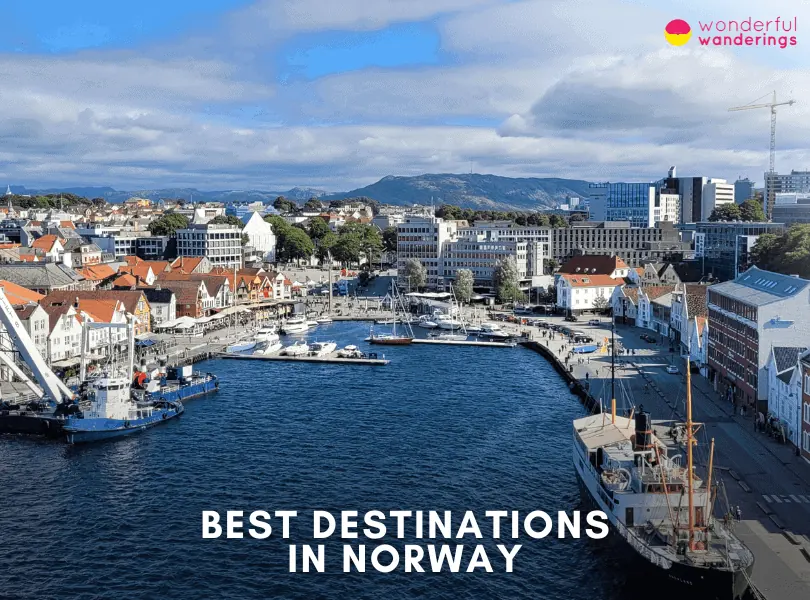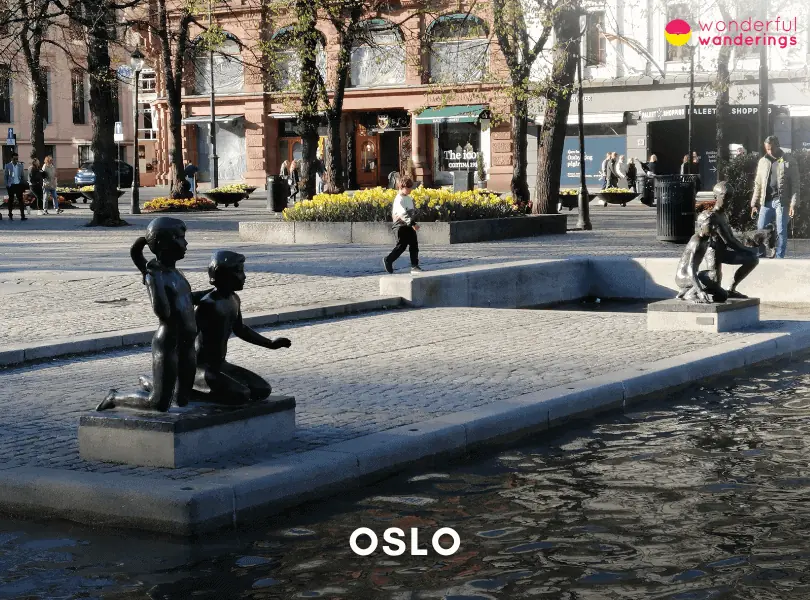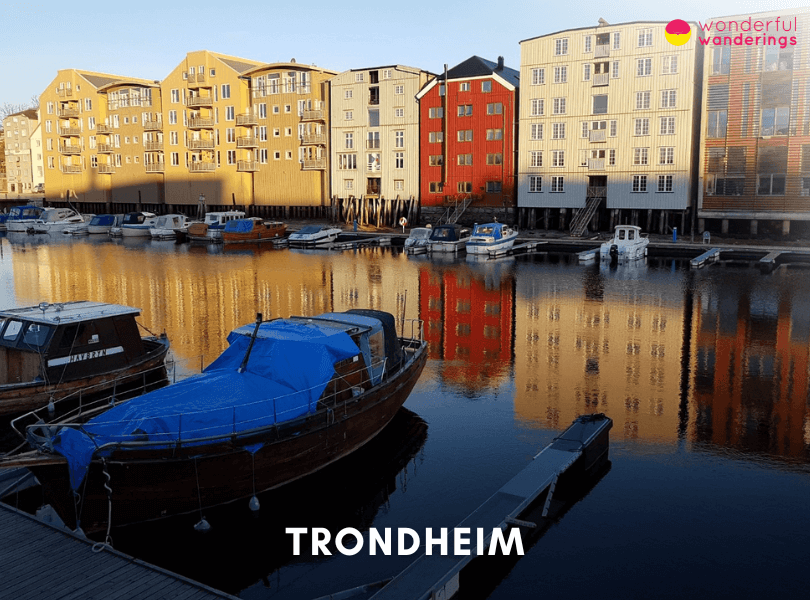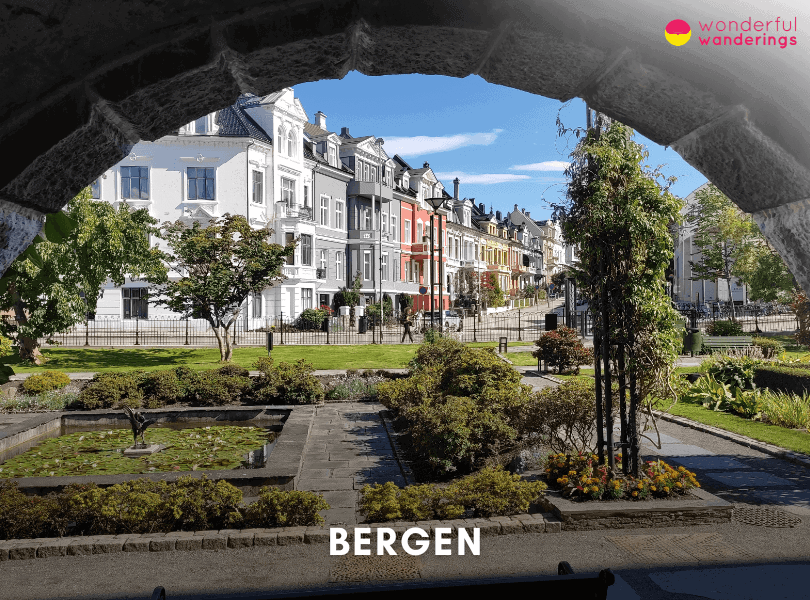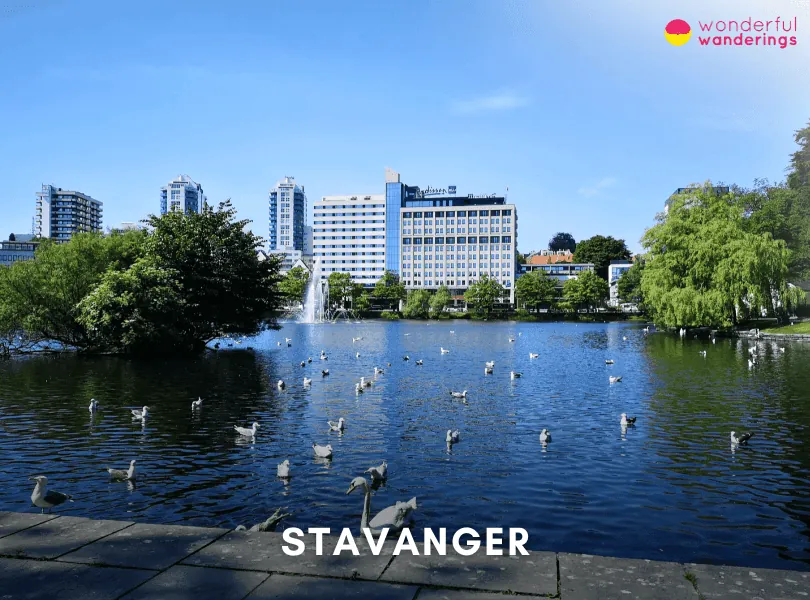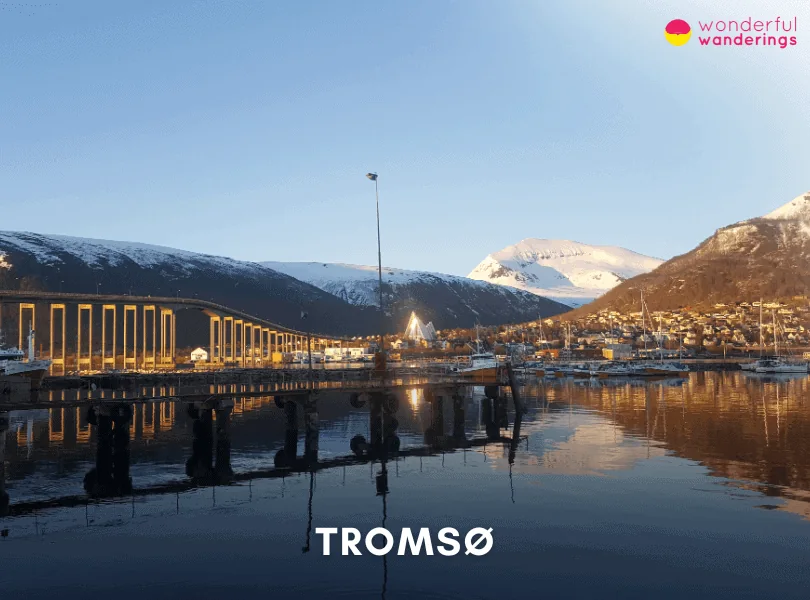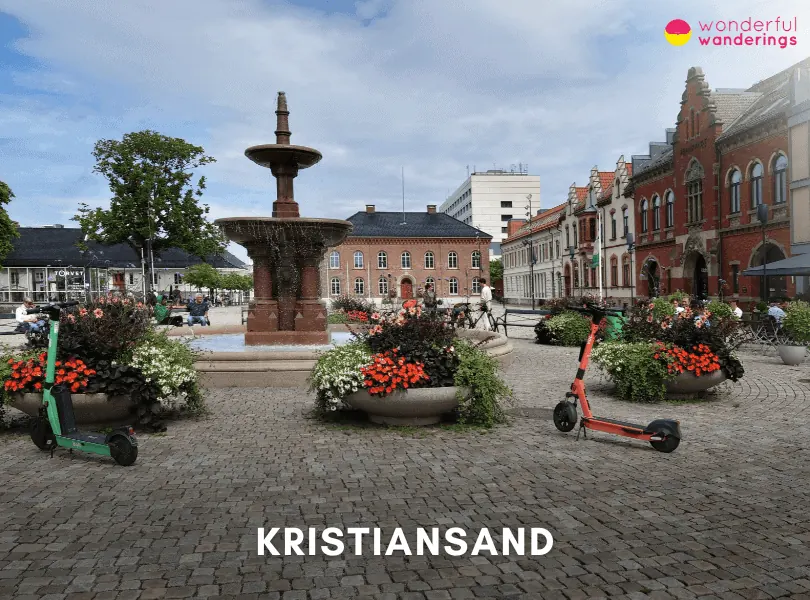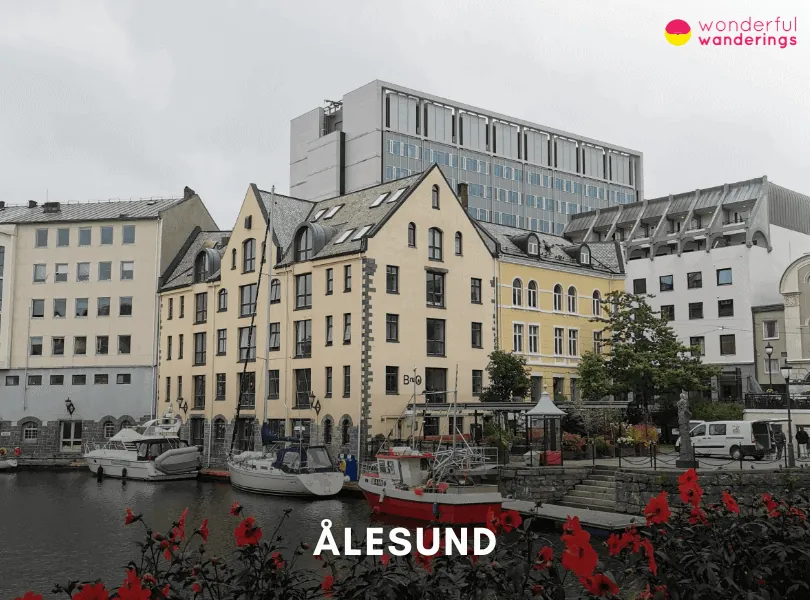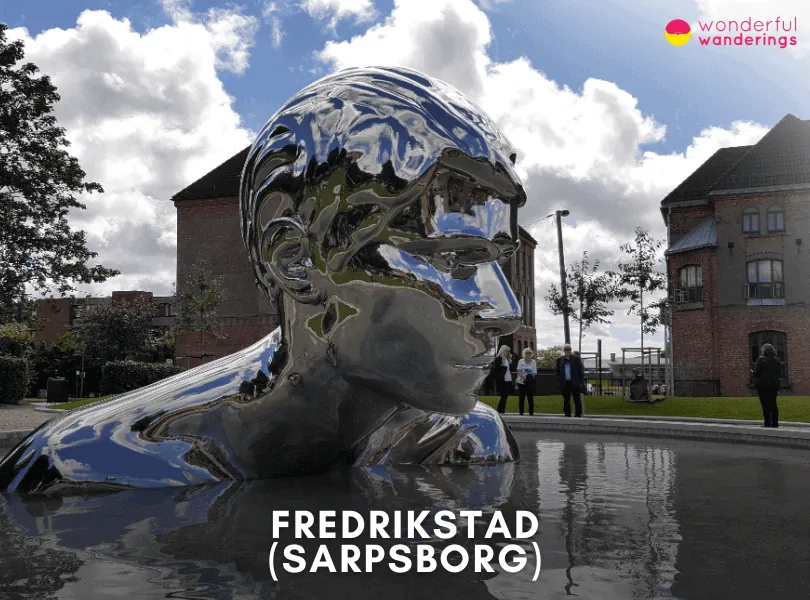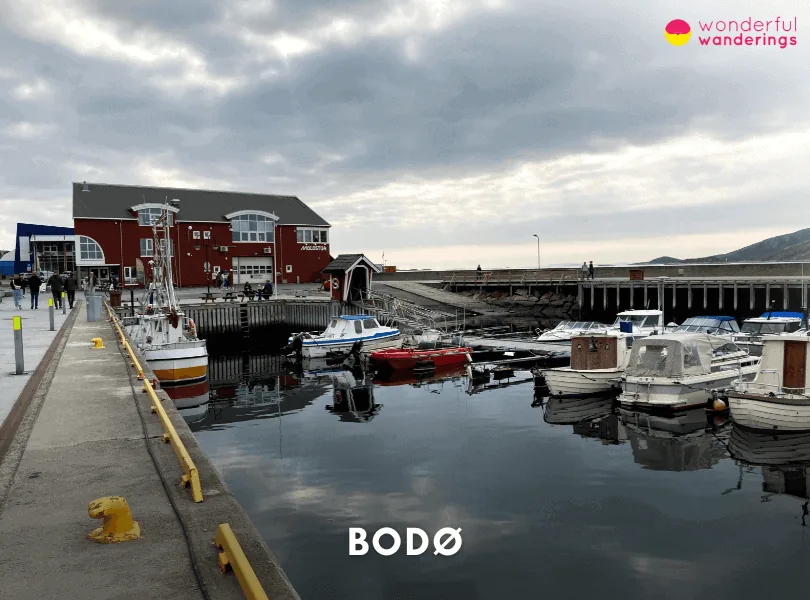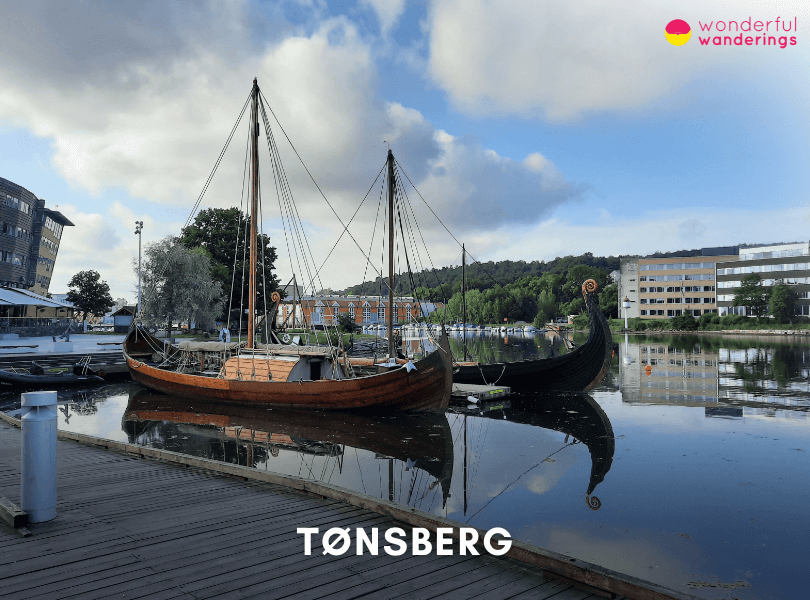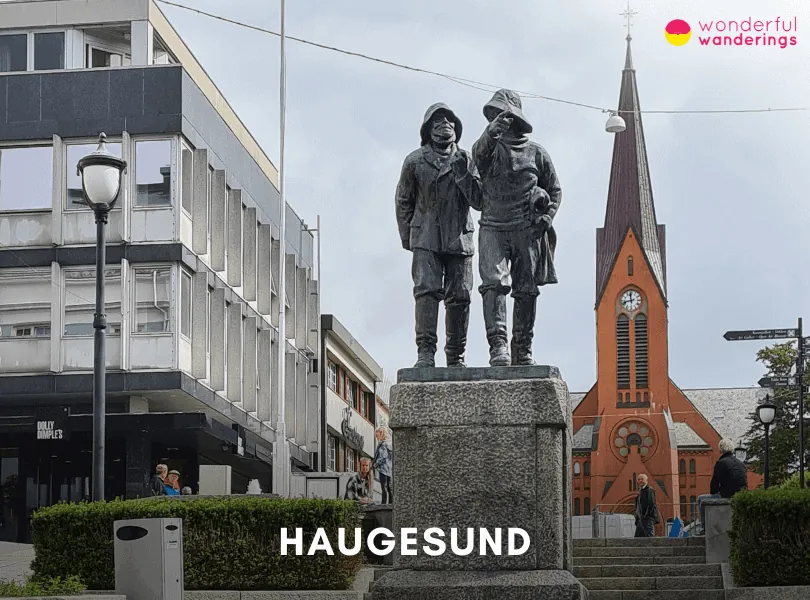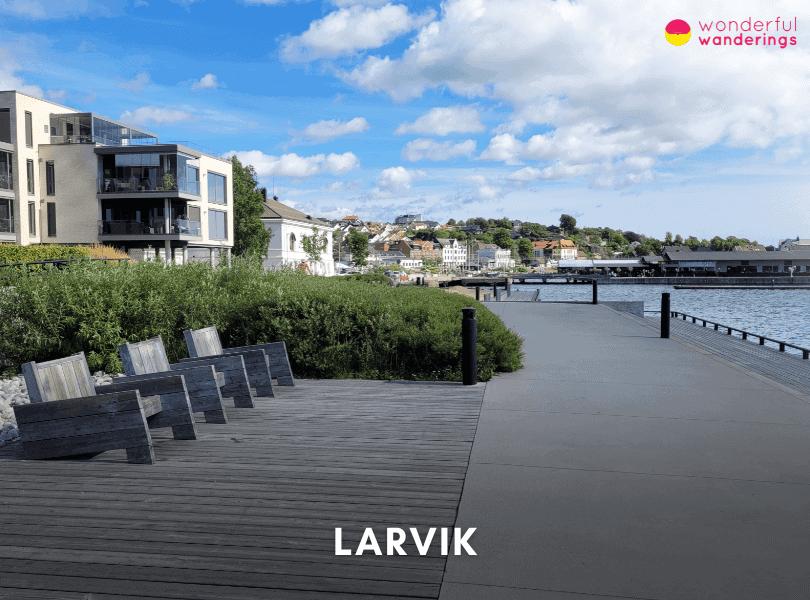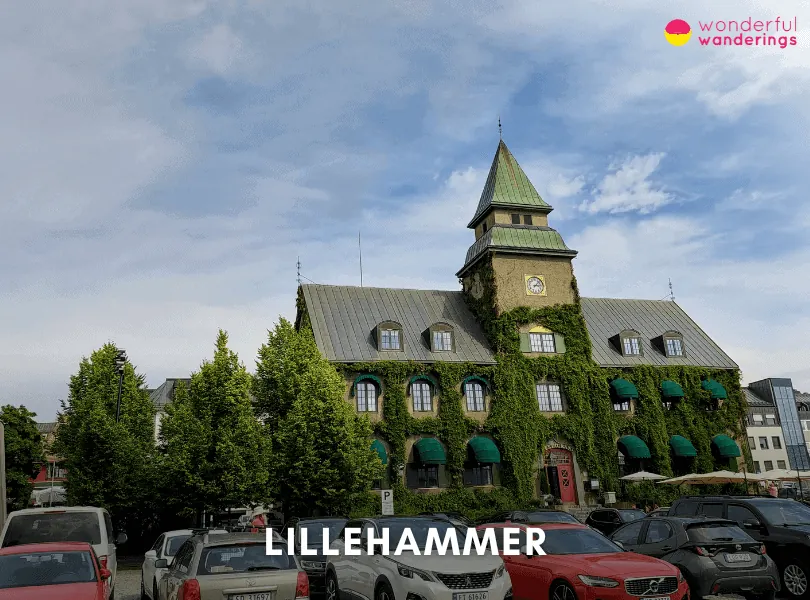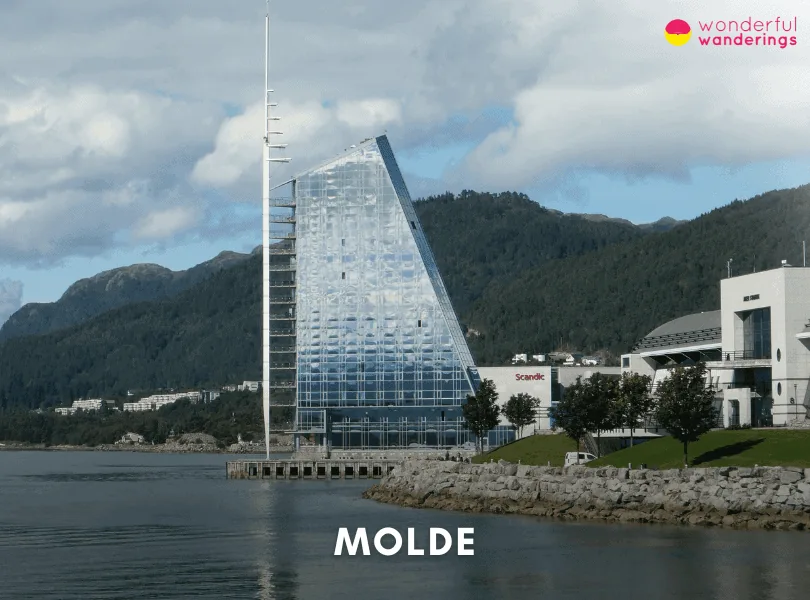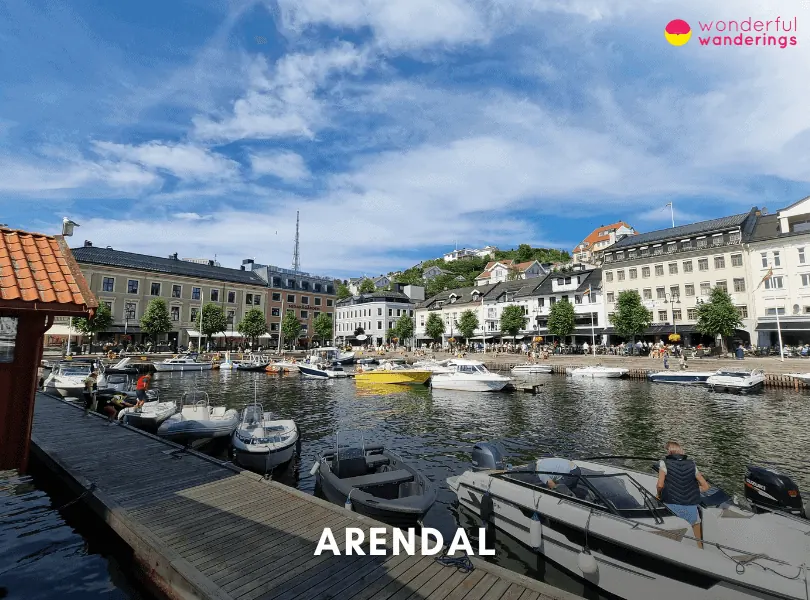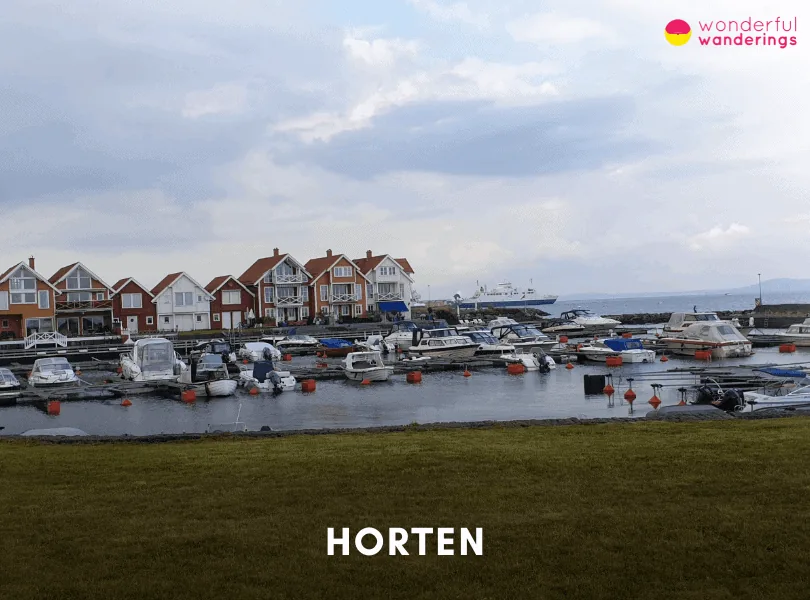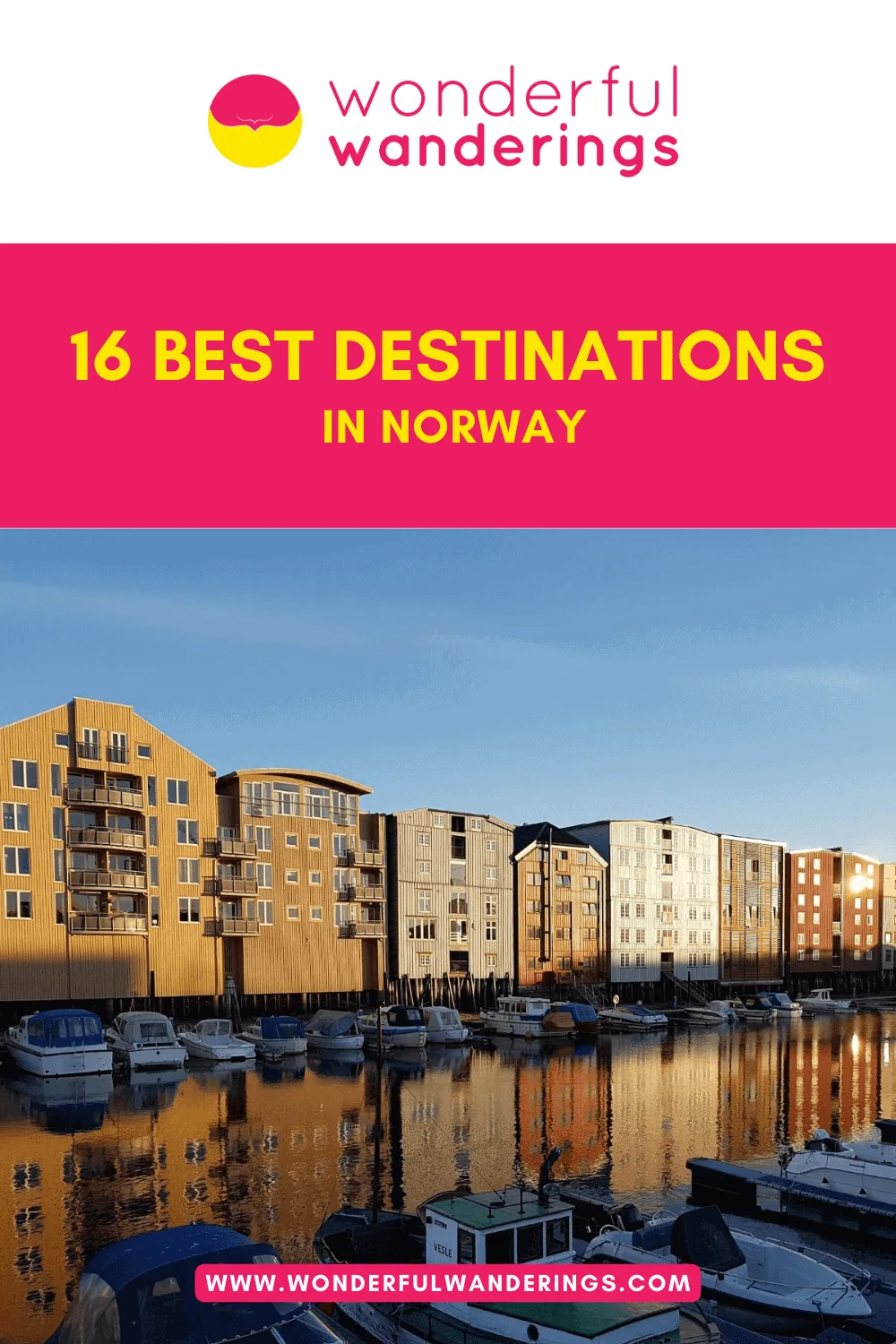Norway is a Scandinavian country in northern Europe with a rich history and modern culture. Oslo is the capital and largest city. Old Norse traditions and contemporary Scandinavian lifestyle and values shape Norway. Norway is renowned for its natural landscapes like imposing mountains, deep coastal fjords carved by ancient glaciers and the phenomenon of the midnight sun visible in the far north during summer. Iconic sights include Pulpit Rock, Trolltunga rock formation, Geirangerfjord, Northern Lights and Lofoten Islands peak hiking. Norway also offers a variety of outdoor adventures, from dog sledding and whale-watching tours to skiing and fishing.
Cities in Norway feature major attractions. Oslo houses the Oslo Opera House, Royal Palace, Akershus Fortress and Nobel Peace Center. Bergen is Norway’s second-largest city, renowned for Bryggen Harbor and the gateway to the fjords. Trondheim is an important historical, religious and cultural hub, home to the famed Nidaros Cathedral. Popular summer activities include hiking, exploring fjords and witnessing the midnight sun in northern Norway. Oslo hosts Constitution Day celebrations on May 17 and Bergen hosts music and food festivals in the summer. Winter activities feature skiing, chasing the Northern Lights and Christmas markets in December. Norway’s cuisines feature healthy ingredients like salmon, trout, mutton, reindeer meat, berries, potatoes and dairy. Popular dishes are Fårikål (lamb and cabbage stew) and Kjøttkaker (meatballs with potatoes).
The best time to visit Norway is summer, from mid-June to mid-August. The average temperatures during the summer in Norway range from 12-18°C (52-65°F), often exceeding 25°C (77°F). This period is considered the high season, offering the best weather, long hours of daylight and a wide range of outdoor activities. Visitors get around via an efficient network of trains, public buses, passenger ferries, domestic flights and rental cars along roads and tunnels. Norway offers all accommodation levels, from hotels, guesthouses, cabins and hostels to campgrounds, where visitors can spend the night and watch the auroras. Good budget travel tips include buying food from grocery stores, limiting spending on alcohol, avoiding taxis and purchasing attraction passes in advance.
1. Oslo
Oslo is the capital and largest city of Norway. It is located in southeastern Norway at the head of the Oslofjord. The history of Oslo dates back over a thousand years. It was founded as a city in 1048 by King Harald Hardrada. Over the centuries, Oslo has been repeatedly destroyed by fires and wars. The modern city was rebuilt after a fire in 1624 under the reign of Christian IV of Denmark-Norway. Oslo became the capital of the independent Kingdom of Norway after Norway’s union with Denmark was dissolved. Oslo is Norway’s economic, political and cultural center.
Oslo is home to many attractions. Major sights include the Oslo Opera House, the Royal Palace, Akershus Fortress, Oslo City Hall, Holmenkollen Ski Museum, Viking Ship Museum, Vigeland Sculpture Park and Munch Museum. Popular outdoor recreational areas include the Nordmarka woods, the Oslofjord islands and the Holmenkollen ski jump. Oslo is also home to world-class museums like the Munch Museum, National Gallery, Viking Ship Museum, Kon-Tiki Museum, Fram Polar Ship Museum and the Nobel Peace Center. The city center features a café culture and historic buildings along Karl Johans gate. The redeveloped harbor area of Aker Brygge offers restaurants, shops and nightlife.
Oslo has a population of 697,549 as of 2023 and covers an area of 480 square kilometers (185 square miles). The GPS coordinates of central Oslo are 59°54′49′′N 10°45′08′′E. Oslo is 47 kilometers (29 miles) from Oslo Airport, serving the city. The best way to reach Oslo is by flying into Oslo Airport and then taking the Flytoget express train, which takes only 19 minutes to get into the city center. Many travelers also arrive in Oslo by train from other destinations in Norway and Europe. Oslo Central Station offers bus, tram and metro connections to other parts of the city.
The best time to visit Oslo is during summer and early fall, from June to September, when average temperatures are pleasant at around 15-20°C (high 50s to mid 60s°F) and long daylight hours. To experience Oslo’s main attractions, most visitors would need 2-3 full days in the city. Top sights like the Opera House, National Museum, Royal Palace, Akershus Fortress, Aker Brygge district, Vigeland Park and Holmenkollen ski jump can be seen in 1-2 days. Visitors can spend the first day exploring top attractions in the city center and Karl Johans gate area. The second day can be used for venturing farther out to sights like Vigeland Park, Holmenkollen, Bygdøy peninsula museums or Aker Brygge. Adding a third day provides time for leisurely exploration at a more relaxed pace, seeing secondary sights or taking a half-day side trip.
2. Trondheim
Trondheim is a city and municipality in Trøndelag county, central Norway. It is located on the southern shore of the Trondheimsfjord at the mouth of the River Nidelva. The history of Trondheim dates back over 1,000 years. It was founded as a trading post in 997 CE by Viking King Olav Tryggvason. He built a church and royal residence there, establishing it as the capital of Norway. In the 11th century, Trondheim grew in importance as a religious center after the burial and later sainthood of King Olav Haraldsson. Nidaros Cathedral was built over his presumed grave site, making Trondheim the northernmost medieval cathedral in the world. Over the centuries, Trondheim thrived as a trade, shipping and religious center. It was the seat of the Catholic Archdiocese of Nidaros from 1152 to 1537. The city remains an important cultural and economic hub of Norway today.
Trondheim offers a wealth of cultural attractions. The city lies the famed Nidaros Cathedral, built over the burial site of Norway’s patron Saint Olav. Its ornate stone Gothic architecture, stained glass windows and stone carvings draw reverent visitors. The adjacent Archbishop’s Palace is now a museum exhibiting the church’s medieval Catholic past. The Ringve Museum complex encompasses several musical history buildings, including an 18th-century manor surrounding a tranquil botanical garden. The old town bridge area known as Gamle Bybro makes up Trondheim’s historical central heart alongside the harbor, lined with 18th and 19th-century warehouses converted into cafés. Museums cover subjects from the daily life of coastal communities to regional art collections. The former fort and prison, Kristiansten, serves as the site for military reenactments and panoramic outlooks above Trondheim.
Trondheim has a population of 177,426 as of 2023. The GPS coordinates of central Trondheim are 63°26′N 10°24′E. Trondheim is 454.3 kilometers (282.2 miles) from Oslo Airport and 463 kilometers (288 miles) from Oslo by road. The best way to get to Trondheim is to fly to Trondheim Airport Værnes located 35 kilometers (21 miles) outside the city center, followed by the Flybussen airport bus or other public transport into town.
The best time to visit Trondheim is during summer, from June to August, when average high temperatures reach a pleasant 15-20°C (mid-50s to 60s°F). The long summer days allow hiking in the forests and exploring outdoor attractions. Most visitors would need about 2-3 days. Top attractions like Nidaros Cathedral, the Old Town Bridge area, Ringve Museum, Kristiansten Fortress and a boat trip on Trondheim Fjord could fill one day. The second day could be used for scenic hikes on the Bymarka or Estenstadmarka forest trails or visiting further sights like the Folk Museum. Add a third day to relax, enjoy Trondheim’s cafes and restaurants and soak in more of its history and culture leisurely.
3. Bergen
Bergen is a historic city on the west coast of Norway. It is often called “the city among the seven mountains” due to its setting. The city was founded in 1070 by King Olaf III Haraldsson and has since become the second-largest city in Norway. Bergen has a rich history as a major trading center, particularly during the era of the Hanseatic League and has been an important port on the west coast of Norway for centuries.
Bergen offers a diverse and enriching experience for visitors. The UNESCO World Heritage Site Bryggen, with its iconic wooden buildings, provides a deep sense of the city’s history and its significance to the people of Bergen and Norway. The Hanseatic Museum, Bryggens Museum and the Theta Museum further contribute to this historical immersion, offering insights into the cultural and historical importance of the region. The city’s strong cultural identity is evident through its status as a proud European City of Culture, with a wide range of concerts, international festivals and museums, including the homes of world-famous artists such as Edvard Grieg and Ole Bull, both of which are popular attractions today. Furthermore, the city’s natural beauty is showcased through attractions such as Mount Floyen and the Funicular, the fish market and the Bergen Aquarium, providing a perfect blend of historical, cultural and natural experiences for all visitors.
Bergen has a population of 290,193 as of 2023. The city is known for its diverse and growing population, with tens of thousands of foreign-born residents and is often referred to as the gateway to the famous Norwegian fjords. Bergen’s GPS coordinates are 60.3943° N and 5.3251° E. The distance to Oslo Airport is 473 kilometers (293 miles) from the city center and the distance to Oslo is (480 kilometers (300 miles) by road. The best way to get to Bergen is by Bergen Airport, Flesland, which offers domestic and international flights. Bergen is accessible by train, bus and boat, with scenic train routes from Oslo and other parts of Norway.
The best time to visit Bergen is during the summer months, from June to August when the average temperatures range from 12°C to 18°C (54°F to 64°F). This period offers the most daylight and is ideal for exploring the city’s outdoor attractions and nearby fjords. Visitors typically need at least 2-3 days to experience the main attractions in Bergen, including Bryggen, the fish market and the surrounding natural landscapes. Visitors can also take day trips to the fjords, enjoy the local cuisine and immerse themselves in the city’s rich cultural heritage.
4. Stavanger
Stavanger is a city on Norway’s southwestern coast in Rogaland, a peninsula between the Boknafjorden and Hafrsfjorden—the first traces of settlement in Stavanger date back to the Iron Age. The city was founded around 1125 when the construction of Stavanger Cathedral was completed under the direction of Bishop Reinald. Stavanger underwent economic hardship as its once-thriving fishing industry declined. The discovery of North Sea oil brought renewed prosperity to the region. Stavanger is a modern city that balances a rich cultural history with its status as Norway’s energy hub.
Stavanger offers visitors plenty of historical sights and museums showcasing the city and region’s past. Gamle Stavanger (Old Town) consists of 173 beautiful wooden houses dating between the 18th and 19th centuries. Visitors can explore the narrow cobblestone streets and imagine what life was like during Stavanger’s era as Norway’s “canning capital”. Stavanger Cathedral is the country’s oldest cathedral in its original medieval state. The impressive stone Gothic structure sits on an elevated hilltop overlooking the city. Another must-see is the Norwegian Petroleum Museum, an architectural wonder shaped like an oil platform that traces the oil industry’s development and impact on Norway.
Stavanger has a population of 128,237 as of 2023, within a total area of about 72 square kilometers (27 square miles). It is considered a harbor city due to its coastal location and history as an important fishing and shipping port. The GPS coordinates of Stavanger are 58°58′N 5°44′E. The distance from Oslo Airport to Stavanger is 460 kilometers and it takes 5 hours by car. Stavanger is 548 kilometers (340 miles) from Oslo city center. Stavanger Airport (SVG) has daily flights from Oslo and several other domestic and international destinations and is the best way to get to Stavanger.
The best time to visit Stavanger is during the summer months between June and August when daylight hours are the longest and temperatures typically range from the mid-50s to low 60s Fahrenheit (13°C to 17°C). Visitors must spend at least two full days in the city to allow enough time to see top attractions like Gamle Stavanger, the cathedral and museums and venture out on a scenic Lysefjord cruise or hike to Pulpit Rock. Stavanger makes the perfect destination for visitors wishing to immerse themselves in Norway’s rich Viking heritage and natural landscape.
5. Tromsø
Tromsø is a city in northern Norway, north of the Arctic Circle, situated along the Tromsøya island and mainland, lies between the fjords and the Reisafjorden, about 350 kilometers north of the Arctic Circle. Tromsø was founded in 1794, relatively recently a Norwegian city. The Danish-Norwegian King issued its city charter in 1794 partly to strengthen Norwegian claims on northern lands against Russia. It grew as an Arctic hunting, fishing and overland expedition center. Tromsø is best known as a major educational and research hub focused on northern lands. The city is home to the University of Tromsø, specializing in northern culture, nature, people and policymaking.
Tromsø offers numerous attractions and activities showcasing Arctic landscapes, nature and culture. Popular highlights include the Polar Museum, which provides background on Arctic expeditions and culture and the northernmost Botanical Garden featuring Arctic and Alpine plants. The city’s coastal location also enables whale-watching tours, fjord cruises and dog sled expeditions. One of Tromsø’s most iconic attractions is its Arctic Cathedral, whose unique triangular design resembles a massive iceberg jutting upward. Visitors can ride a cable car up Mt. Storsteinen just outside the city to glimpse spectacular views of Tromsøya Island’s mountainous terrain.
Tromsø has a population of 70,137 as of 2023 within a total area of 2,566 square kilometers (990 square miles). It is the largest urban area in northern Norway and is regarded as the “Gateway to the Arctic” given its far northern location. The GPS coordinates for Tromsø are 69°38′58′′N 18°55′59′′E. It is 1,000 kilometers (621 miles) from Oslo Airport and 1,030 kilometers (640 miles) from Oslo city center. The best way to get to Tromsø is to fly or take the Hurtigruten coastal cruise ship.
The best time to visit Tromsø is during the summer months of June and July when the city enjoys almost constant daylight and mild temperatures. The average temperatures during this period range from 10°C to 15°C (50°F to 59°F), providing a comfortable environment for exploring the city and its surrounding natural wonders. A 3-day visit to Tromsø provides ample time to see the top city attractions and venture outside Tromsø on scenic excursions. Potential activities over three days could include a city highlights walking tour, Arctic Cathedral visit, whiskey tasting, fjord cruise whale watching combo and reindeer sledding.
6. Kristiansand
Kristiansand is a city and municipality in southern Norway in the county of Agder. Kristiansand was founded in 1641 by King Christian IV of Denmark-Norway. Historically an important harbor and trade hub, the city occupies the sandy region between the mouth of the river Otra and the North Sea. Kristiansand showcases many examples of the wooden architecture that was once common in Norwegian coastal cities before extensive 19th-century fires.
The city’s main pedestrian street, Markens, is bustling with life and is home to various shops, restaurants and entertainment venues. Kristiansand’s urban beach, Bystranda, provides a unique experience with fine sand and palm trees, feeling like being in more southern parts of Europe. The city’s cultural venues, such as Kilden, a landmark building that houses a theatre and a music hall with an exciting program, offer visitors a wide range of entertainment options. The city’s cool, urban vibe is reflected in its extensive street art, with gigantic murals and more subtle pieces adorning the streets. Kristiansand is also a family-friendly destination known as “the children’s city”, with attractions such as Kristiansand Zoo and Amusement Park, the largest zoo in Norway and a big water park in the summer.
Kristiansand has a population of 67,291 as of 2023. Kristiansand is on Norway’s southern Skagerrak coast, 370 kilometers (230 miles) southwest of Oslo. It is located at geographic coordinates 58.17° N, 8° E. The distance from Oslo Airport to Kristiansand is 292 kilometers (181 miles). The best way to reach Kristiansand is by air. Kristiansand Airport is 12 kilometers (19 kilometers) east of the city center. The most frequent air connections are with Oslo, operated by Scandinavian Airlines and Widerøe.
The best time to visit Kristiansand is late spring to early autumn, roughly May through September, when average high temperatures range between 15°C (59°F) and 22°C (72°F). This is the most popular season for outdoor recreation, cultural festivals/concerts and exploring offshore islands. Many attractions have limited operations or close entirely during the colder late fall and winter months. It is recommended to spend 2-3 days to take in key sites like Kilden Performing Arts Centre, Kristiansand Zoo or Christiansholm Fortress, along with nearby islands perfect for swimming, boating, fishing or simply appreciating the scenic archipelago. A visit to the historic town of Lillesand and the Blindleia island area can also easily be combined with the 2-3 day itinerary.
7. Ålesund
Ålesund is a city and municipality in Møre og Romsdal, Norway. It is on the west coast of Norway, at the entrance to the Geirangerfjord, a UNESCO World Heritage site and is known for its unique Art Nouveau architecture. The city is the principal shipping town of the Sunnmøre district. It serves as the region’s cultural center, attracting tourists due to its proximity to the fjords and the presence of the Ålesund Aquarium. The history of Ålesund dates back to the 9th century and the town was officially founded in 1835. The town experienced a devastating fire in 1904, which led to its reconstruction in the Art Nouveau architectural style, a unique and consistent feature of the city. The town’s growth and development have been influenced by its strategic location and importance as a regional shipping and cultural center.
The main attractions in Ålesund include the Norwegian Centre of Art Nouveau Architecture, a museum and interpretive center and the Sunnmøre Museum, an outdoor folk museum devoted to the Norwegian coastal culture and way of life. The city’s unique architecture, with its Art Nouveau buildings, is a major draw for visitors and the town’s coastal location and proximity to the fjords offer a wide range of outdoor and cultural experiences for tourists. The town is also known for its cultural scene and annual festivals and events, attracting visitors from around the world.
Ålesund has a total population of 67,114 as of 2023, making it Norway’s 13th most populous municipality. The town’s geographical location is on Norway’s west coast, adjacent to the Geirangerfjord. The GPS coordinates of Ålesund are 62.4722° N and 6.1549° E, placing it on the west coast of Norway. The distance to Oslo Airport and its city center is 500 kilometers (310 miles). The best way to get to Ålesund is by air, as the town is served by Ålesund Airport, Vigra, which offers domestic and international flights. The town is accessible by sea, with ferry services connecting it to other parts of Norway and the region’s islands.
The best time to visit Ålesund is during the summer months, when the town enjoys a temperate marine west coast climate, with average temperatures ranging from 10°C to 15°C (50°F to 59°F). This period offers the most daylight and is ideal for exploring the town’s outdoor attractions and nearby fjords. Visitors need 2-3 days to experience the main attractions in Ålesund, including the Norwegian Centre of Art Nouveau Architecture, the Sunnmøre Museum and the town’s unique Art Nouveau buildings. Visitors can also take advantage of the town’s unique outdoor activities, such as hiking, boating and exploring the nearby Geirangerfjord, a UNESCO World Heritage site. The city’s cultural heritage, architecture and natural surroundings make it a captivating destination for visitors worldwide.
8. Fredrikstad/Sarpsborg
Fredrikstad/Sarpsborg is a combined urban area in Norway, consisting of the municipalities of Fredrikstad and Sarpsborg and several smaller towns in between and on the outside of the core of the cities. The area has a rich history, with Fredrikstad being founded in 1567 by King Frederick II and established as a municipality on 1 January 1838. The city was built at the mouth of the Glomma River as a replacement after the Swedes burned down Sarpsborg in the 1500s. The city’s old town is Northern Europe’s best-preserved fortified town. Sarpsborg, on the other hand, was rebuilt at its original site and regained its city status in 1839. The city center of Fredrikstad is on the west bank of the Glomma, while the old town on the east bank is Northern Europe’s best-preserved fortified town. Its strategic location and importance as a regional shipping and cultural center influenced the area’s development.
Fredrikstad/Sarpsborg features the cultural history of two settlements – a fortress town and Europe’s best-preserved, star-shaped fortress of Fredrikstad, which dates to 1663, while Sarpsborg’s Vikings and Middle Age past are the modern industrial backdrop to magnificent scenery of waterfalls, lakes and forests. Fredrikstad features the Østfold Art Museum with extensive Norwegian collections, a Nostalgia-filled Resident Museum Olavs Gård, the harbor Potetkjelleren Restaurant and ferry cruises out to Hvaler Islands with beaches and fishing villages. Sarpsborg’s landmark attraction of Borregård is where Norway’s King resided in the Middle Ages and has a park and 17th-century mansion tours. Sarpsborg waterfall, one of Norway’s tallest at 94 meters, provides hiking across plank walkways, spiraling staircases and observation platforms.
The region has developed to the extent that it is now considered one urban area. It is the seventh largest urban area in Norway, with a combined population of 141,708 as of 2023, 83,761 residing in Fredrikstad and 57,947 in Sarpsborg. The city’s geographical coordinates are 59.2104° N, 10.9458° E. The area is 20 kilometers (12 miles) from the Swedish border and 100 kilometers (62 miles) south of Oslo, the capital of Norway. The best way to get to Fredrikstad/Sarpsborg is by train. Norwegian State Railways (NSB) offers frequent and convenient services from Oslo to Fredrikstad and Sarpsborg. The travel time by train is 1.5 to 2 hours, making it a comfortable and efficient mode of transportation.
The best time to visit the Fredrikstad/Sarpsborg area is during the summer months, when the region enjoys a temperate marine west coast climate, with average temperatures ranging from 10°C to 15°C (50°F to 59°F). This period offers the most daylight and is ideal for exploring the area’s outdoor attractions and nearby historical sites. Visitors need 2-3 days to experience the main attractions in the region, including the old town of Fredrikstad, the well-preserved fortress and the area’s unique architecture. Visitors can take advantage of the region’s outdoor activities, such as hiking, boating and exploring the nearby Glomma River and the Oslofjord, which offer various cultural and historical experiences. The region’s unique blend of cultural heritage, architecture and natural surroundings makes it a captivating destination for visitors worldwide.
9. Bodø
Bodø is an urban area in Nordland county, Norway. It is north of the Arctic Circle, making it the largest urban area in Nordland County and the second-largest town in the region. The history of Bodø dates back to the 19th century when the town was established as a municipality on 1 January 1838. The town was built at the mouth of the Glomma River and has since developed into a significant cultural and economic center in the region. Bodø’s growth and development have been influenced by its strategic location and importance as a regional shipping and cultural center. The city’s historical significance is reflected in its well-preserved architecture and cultural scene, including annual festivals and events that attract visitors worldwide.
Bodø is the gateway to Norway’s rugged northern reaches, north of the Arctic Circle. The city features the Nordland Museum, built in the 1950s around the remains of a medieval castle, displaying traditional life in Nordland County through history. Panoramic views reward those who dare to climb the Bodin Church lookout tower. Outdoor enthusiasts flock to Bodø and the surrounding scenic Salten region for adventures. Accessible islands house popular puffin colonies, while offshore waters promise whale watching. The Saltfjellet mountain area provides marked trails to traverse forests and tundra with wildlife sightings. The Saltstraumen strait nearby intrigues visitors as one of the world’s strongest maelstroms, formed by massive tide fluxes. Bodø’s harbor bustles with the Hurtigruten Coastal Steamer docking on its journey between Bergen and Kirkenes. The Norwegian Aviation Museum documents Bodø’s airport significance during World War II. Festivals, from winter codfish gastronomy to summer rock music, keep visitors entertained. With striking seascapes and mountain vistas never far away, Bodø is the gateway to experience Norway’s rugged northern beauty above the Arctic Circle.
Bodø covers an area of 1,395.33 square kilometers (538 miles) and has a population of 52,803 as of 2023, with GPS coordinates of 67.2804° N and 14.4049° E. The distance from Bodø to Oslo Airport is 725 kilometers (450 miles) and 805 kilometers (500 miles) from Oslo’s city center. The best way to get to Bodø is by air, as Bodø is served by Bodø Airport, which offers domestic and international flights. The airport is 2 kilometers (1.2 miles) from the city center, making it a convenient and efficient mode of transportation.
The best time to visit Bodø is during the summer months, when the region enjoys a temperate marine west coast climate, with average temperatures ranging from 10°C to 15°C (50°F to 59°F). This period offers the most daylight and is ideal for exploring the area’s outdoor attractions and nearby historical sites. It is recommended to spend 2-3 days to experience the main attractions in the region, including the old town of Bodø, the well-preserved architecture and the area’s unique natural surroundings. Visitors can also take advantage of the region’s outdoor activities, such as hiking, boating and exploring the nearby Glomma River and the Oslofjord, which offer various cultural and historical experiences.
10. Tønsberg
Tønsberg is in Vestfold og Telemark county, Norway. It is on the western coast of the Oslofjord, making it the oldest town in Norway and a significant cultural and economic center in the region. Tønsberg has a rich history, dating back to the Viking Age and it was founded before the year 871. The town’s historical significance is reflected in its well-preserved architecture and cultural scene, including annual festivals and events that attract visitors worldwide.
Tønsberg features historic warehouses converted into an inviting coastal marketplace that now line the harbor, offering locals and visitors enticing shops, cafés and restaurants. The town wharf features the Jeppe Møe statue honoring the captain who negotiated the release of 27 Norwegian captives from Barbary pirates in the 1800s. The Slottsfjellet Museum in Tønsberg brings history alive through archaeological excavations. The Jarlsberg Manor in south of Tønsberg offers guided tours exhibiting Norwegian nobility life from 1650 to today.
Tønsberg has a total population of 42,396. The city’s location on the Oslofjord’s western coast provides an abundant natural environment with a temperate marine west coast climate. The GPS coordinates of Tønsberg are 59.2671° N and 10.4076° E, placing it on the western coast of the Oslofjord. The town is located 120 kilometers (74 miles) south of Oslo, the capital of Norway. The distance to Oslo Airport is 100 kilometers (62 miles). The best way to get to Tønsberg is by train; Norwegian State Railways (NSB) offers frequent and convenient services from Oslo to Tønsberg. The travel time by train is 1 to 1.5 hours, making it a comfortable and efficient mode of transportation.
The best time to visit Tønsberg is during the summer when the city enjoys a temperate climate with average temperatures ranging from 15°C to 25°C. Visitors typically need 2-3 days to experience the main attractions in the region, including the Tønsberg Fortress, the Oseberg Ship and the town’s unique natural surroundings. Visitors can also take advantage of the region’s outdoor activities, such as hiking, boating and exploring the nearby Oslofjord, which offers a wide range of cultural and historical experiences.
11. Haugesund
Haugesund is in Rogaland county, Norway. It is on the western coast of Norway, on the North Sea and is the region’s main commercial and economic center in northern Rogaland and southern Haugaland. The history of Haugesund dates back to the Viking Age and the town has a strong historical bond to the sea, especially the herring. The coastal waters off Haugesund were a huge source of herring, which led the town to grow. The protective strait of Karmsund and the fjords gave the town the potential to grow in both fishing and shipping. The town is still growing geographically even though the population has increased only moderately in the last decade. Haugesund has established its position as the main trading center for the region and southern parts of Rogaland County.
The Sildagrossen complex in Haugesund represents the historic fish landings and includes an aquarium highlighting regional marine life alongside dining venues focusing on seafood specialties. The Norwegian International Herring Festival, held every August, hosts musical events drawing big Norwegian acts and crowds and the Coastal Culture Centre houses rotating exhibits related to coastal heritage. Visitors who are fond of adventure will love the walking trails ascending Mount Drommedaren with panoramic views over Haugesund’s coastal landscape. The white lighthouse beacon on the adjacent island of Karmøy signifies ships have reached Haugesund for centuries. Visitors can also explore the rugged North Sea on a RIB boat safari ride from the harbor.
Haugesund has a total population of 37,444 as of 2023. The GPS coordinates of Haugesund are 59.2671° N and 5.3099° E, placing it on the western coast of Norway. The distance to Oslo Airport is 300 kilometers (184 miles) and the distance to Oslo city center is 400 kilometers (248 miles). The best way to get to Haugesund is by air, by Haugesund Airport, which offers domestic and international flights. The airport is 8 kilometers (4 miles) from the town center, making it a convenient and efficient mode of transportation.
The best time to visit Haugesund is during the summer, when the region enjoys a temperate marine west coast climate, with average temperatures ranging from 15°C to 25°C. Visitors typically need at least 2-3 days to experience the main attractions in the region, including the Haraldshaugen, the town’s unique natural surroundings and the area’s strong historical bond to the sea.
12. Larvik
Larvik is in Vestfold og Telemark county, Norway. It is on the western coast of the Oslofjord, making it a significant cultural and economic center in the region. The history of Larvik dates back to ancient times, with various remains from the Viking Age and the Stone Age discovered throughout the municipality. The town achieved market status in 1671 and has a strong historical bond to the sea. Larvik is also known as the hometown of Thor Heyerdahl, the famous Norwegian explorer and ethnographer. The town’s historical significance is reflected in its well-preserved architecture and cultural scene, including annual festivals and events that attract visitors worldwide.
Visitors take short trips in Larkvik to the resort island of Staverns and its vintage Elizabeth Tower. Outside Larvik lies the Fritzøe Brygge marina area with beaches, campgrounds and activities. The city also highlights the prehistoric Jettegrytene rock formations carved out by glaciers, which draw visitors along the Larvik River. Cyclists and hikers flock to the woodlands of Hammerdalen or artist Edvard Munch’s nearby estate, offering guided tours. Larvik’s most famous attraction, the Norwegian Geological Museum, displays meteorites and minerals within a former manor house’s natural history collection.
Larvik has a total population of 47,777. The town’s geographical location on the Oslofjord’s western coast provides an abundant natural environment with a temperate marine west coast climate. The GPS coordinates of Larvik are 59.0536° N and 10.0353° E, placing it on the western coast of the Oslofjord. The distance to Oslo Airport is 150 kilometers (93 miles) and to Oslo’s city center is 120 kilometers (74 miles). The best way to get to Larvik is by train; Norwegian State Railways (NSB) offers frequent and convenient services from Oslo to Larvik. The travel time by train is 1 to 1.5 hours, making it a comfortable and efficient mode of transportation.
The best time to visit Larvik is during the summer, when the region enjoys a temperate marine west coast climate, with average temperatures ranging from 15°C to 25°C. Visitors typically need at least 2-3 days to experience the main attractions in the region, including the Haraldshaugen, the town’s unique natural surroundings and the area’s strong historical bond to the sea. Visitors can also take advantage of the region’s outdoor activities, such as hiking, boating and exploring the nearby Oslofjord, which offers a wide range of cultural and historical experiences.
13. Lillehammer
Lillehammer is in the Innlandet county of Norway. It is in the Gudbrandsdalen Valley, 180 kilometers (11 miles) north of Oslo, the capital of Norway. The history of Lillehammer dates back to the 19th century when the town was established as a market town in 1827. The town’s historical significance is reflected in its well-preserved architecture and cultural scene, including annual festivals and events that attract visitors worldwide. Lillehammer gained international attention when it hosted the 1994 Winter Olympics, further solidifying its reputation as a premier winter sports destination.
Lillehammer offers plenty for visitors to experience. As host of the 1994 Winter Olympics, many facilities, like the ski jump towers and the Olympic Bobsleigh and Luge Track, remain open for public use. The Norwegian Olympic Museum documents the games and Norway’s sporting history. The Maihaugen open-air museum stretches over 200 buildings exemplifying traditional architecture across Norway. The Oscarshall Castle sits regally on a hillside overlooking Lake Mjøsa, with royal furnishings inside and a trail circling the grounds. Art aficionados flock to the Lillehammer Art Museum and its sister gallery of contemporary art with avant-garde installations. Quaint cafes, local shops and restaurants line the town’s main street, Storgata. The Olympic Park contains recreational trails that convert to cross-country ski tracks in winter, while chair lifts transport summer hikers hills. Annual events include winter sports contests, food, film festivals and concerts showcasing stars. Lillehammer promises both Olympic legacy and Norwegian traditions.
Lillehammer has a total population of 20,136 as of 2023. The town’s geographical location in the Gudbrandsdalen Valley provides easy access to the surrounding national parks and outdoor activities. The GPS coordinates of Lillehammer are 61.1151° N and 10.4662° E, placing it in the heart of the Gudbrandsdalen valley. The distance to Oslo Airport is 180 kilometers (111 miles) by road, sharing the distance to its city center. The best way to get to Lillehammer is by train; Norwegian State Railways (NSB) offers frequent and convenient services from Oslo to Lillehammer. The travel time by train is 2 hours, making it a comfortable and efficient mode of transportation.
The best time to visit Lillehammer is during the summer when the region enjoys a temperate climate with average temperatures ranging from 15°C to 25°C. Visitors need 3-4 days to experience the main attractions in the region, including the Maihaugen open-air museum, the Norwegian Olympic Museum and the Hunderfossen Family Park. Visitors can also take advantage of the region’s outdoor activities, such as hiking, biking and fishing and explore the nearby national parks, which offer various cultural and historical experiences.
14. Molde
Molde is in Møre og Romsdal county, Norway. Molde is renowned for its scenic beauty and rich cultural heritage. The history of Molde dates back to the late 15th century when it was established as a timber trading port. Molde has evolved into a cultural and economic center, attracting locals and tourists with its stunning landscapes and various activities. Molde gained international recognition when it hosted the Molde International Jazz Festival, the oldest jazz festival in the world and the most important one in Norway, which has been held annually since 1961.
Molde is best known for its panoramic view of 222 mountain peaks across the fjord, which has garnered it the nickname “the town of roses and vistas”. The city’s popular shoreline promenade gives access to this iconic Molde panorama. The main town area also features colorful wooden houses and an attractive public park surrounding the town hall. A top sightseeing spot is the Varden viewpoint, which can be reached by climbing or driving up a winding mountain road to take in sprawling views of the islands and mountains surrounding Molde. The city’s contemporary art gallery is a cultural hub for changing exhibitions. The fishing village of Bjørnsund, with red and white fishermen’s cabins, also attracts visitors. Active travelers often pass through Molde for the neighboring ski resort of Romsdalen and the Mardalsfossen waterfall, accessible after a hike through the Romsdalen Valley.
Molde has a total population of 32,002 as of 2023. The town’s geographical location on the northern shore of the Romsdalsfjord provides easy access to the surrounding mountains and outdoor activities. The GPS coordinates of Molde are 62.7375° N and 7.1604° E, placing it on the northern shore of the Romsdalsfjord. The distance to Oslo Airport is 460 kilometers (285 miles) and 500 kilometers (310 miles) from the capital city by air. The best way to get to Molde is by Molde Airport. The airport offers domestic and international flights and is 5 kilometers (3.1 miles) from the town center, making it a convenient and efficient mode of transportation.
The best time to visit Molde is during the summer when the region enjoys a temperate climate with average temperatures ranging from 15°C to 25°C. Visitors need 3-4 days to experience the main attractions in the region, including the Romsdal Museum, the Varden viewpoint and the Hjertøya island. The city offers outdoor activities, such as hiking, boating and exploring the nearby mountains and the Romsdalsfjord, which offer visitors a wide range of things to discover.
15. Arendal
Arendal is in southeastern Norway. It is along the Agder coast in the southern part of the country, 175 kilometers (108 miles) southwest of Oslo. The history of Arendal dates back to the 16th century when a village called Arendall was established in the area. It was granted town privileges in 1723 by the Danish-Norwegian king. Arendal grew into an important shipping and mining town, with frequent contact abroad that influenced the local culture. Arendal went through an economic decline in the late 1800s and has rebounded with industries such as boat manufacturing, mechanics, electronics and tourism.
Some top attractions that draw visitors to Arendal include its townscape along the waterfront, which features colorful wooden houses and a harbor area. The old town of Tyholmen is renowned for its well-preserved traditional buildings that line the streets and wharves. Adjacent to the harbor lies the Pollen area, with numerous cafes, pubs, restaurants and fish markets that come alive during the summer. The contemporary art gallery Bomuldsfabriken is one of Southern Norway’s largest spaces for temporary art exhibitions and resides in an old textile factory. The iconic Store Torungen lighthouse was built in 1844, offering tours and scenic views across the archipelago. The remains of the once-mining community on Tromøya island make an intriguing excursion for history enthusiasts. The KUBEN Museum tells the industrial story of Arendal combined with diverse special exhibitions. Annual events range from the summer Chamber Music Festival, which hosts world-renowned classical concerts, to arts and food festivals catering to locals and visitors.
Arendal has a total population of 32,600 as of 2023. The GPS coordinates for central Arendal are 58°28′N 8°46′E. The town is located 175 kilometers (108 miles) from Oslo Airport or a 2.5-hour drive. It is 205 kilometers (127 miles) and a 3-hour drive from Oslo city center. The best way to get to Arendal is by car. The E18 motorway provides a direct and well-maintained road connection between Oslo and Arendal, offering an efficient mode of transportation.
The best time to visit Arendal is during the summer when the region enjoys a temperate climate with average temperatures ranging from 15°C to 25°C. Visitors typically need 3-4 days to experience the main attractions. Visitors can spend a day wandering around the sights in central Arendal, including the harbor, museums and cafes. Another day can be used to take a guided kayak tour around the skerries or hike a coastal trail on one of the islands. Catch a music performance at a cafe or concert hall in the evening. One more day allows time for an excursion to a historic village like Moland, a boat ride to Merdø or relaxing at a beach.
16. Horten
Horten is in Vestfold og Telemark county, Norway, on the western shore of the Oslofjord. Horten is renowned for its rich maritime history, stunning natural landscapes and cultural scene. The town is often referred to as the “Marine City” due to its historical and contemporary ties to the sea and it is a popular destination for visitors seeking a harmonious blend of natural splendor and cultural experiences. The history of Horten dates back to ancient times when it was a significant center of power in the Viking Age. The town has become a cultural and economic center, attracting locals and tourists with its stunning landscapes and various activities.
Horten gained international recognition when it became one of Norway’s biggest port towns in the late 19th century and it has since maintained its status as an important hub for maritime activities. Horten offers a variety of attractions for visitors, including the Karljohansvern, the Norwegian Naval Museum and the beautiful Borre National Park. Karljohansvern is a former naval base transformed into a cultural and historical center. The Norwegian Naval Museum provides an in-depth look into the town’s maritime history. The Borre National Park is home to Norway’s largest known burial site and has the largest collection of king’s graves in Scandinavia.
Horten has a total population of 18,622 as of 2023. The geographic coordinates of the city center are 59°25′N and 10°29′E. Horten covers a total geographic area of 70 square kilometers (43 miles). It also includes small villages such as Åsgårdstrand, Skoppum and Borre. The city center sits 93.8 kilometers (58 miles) from Oslo, making it an easy day trip. The best way to get to Horten is by car. The E18 motorway provides a direct and well-maintained road connection between Oslo and Horten, offering an efficient mode of transportation.
The best time to visit Horten is during late spring, summer and early fall when daylight hours are long, the weather is mild and most attractions are open. Popular summer activities include exploring the scenic archipelago islands perfect for boating, swimming at family-friendly beaches or visiting summer music festivals. Temperatures typically range from around 15°C to 22°C (59°F to 72°F) between June and August. It is recommended to stay for 2 or 3 days to experience Hosten. Visitors can take a walking tour of the Horten harborfront district, naval museums and classic car collections one day. Visitors can also hike across Borre National Park or quickly ferry to Ula and Åsgårdstrand. The evening restaurants, bars and cafés offer a nice way to relax after an active day of sightseeing. Visitors can also check out the cultural calendar for special events like Karljohansvern Fortress concerts.
What is the best place to visit in Norway during the summer?
Tromsø is the best place to visit in Norway during the summer. Firstly, Tromsø offers a variety of activities, including hiking, fishing and exploring museums and historical sites, allowing visitors to immerse themselves in the city’s rich cultural heritage while enjoying the unique natural phenomenon of the midnight sun. The city also provides opportunities for whale-watching tours, cable car rides to Mount Storsteinen for panoramic views and the chance to meet and feed domesticated reindeer with the indigenous Sami people, offering a culturally sustainable experience. Secondly, Tromsø’s summer weather has longer days and warmer temperatures, making it easier for visitors to hike, enjoy the park’s scenery, swim or catch waves surfing in the ocean. Lastly, visitors can witness the midnight sun phenomenon, creating a magical and unforgettable atmosphere.
What is the best place to visit in Norway during the winter?
Tromsø is the best place to visit in Norway during the winter. Firstly, Tromsø is renowned as the “Gateway to the Arctic” and offers a unique winter experience. The city’s northern location makes it an ideal destination for witnessing the northern lights. Secondly, Tromsø is the most popular winter destination in Norway, with snow-covered streets, classic Norwegian architecture, winter boat rides on the fjords and museums delving into the unique culture of Arctic Norway. Thirdly, Tromsø is also a prime location for guided tours to witness the aurora borealis during the dark days of November, December and January. Lastly, a series of activities, such as skiing, snowmobiling, dog-sledding and snowshoeing, make it a top choice for a winter getaway in Norway.
What is the best place to visit in Norway during Christmas time?
Bergen is the best place to visit in Norway during Christmas time. Firstly, one of the highlights of the Bergen Christmas experience is the “Pepperkakebyen”, the largest gingerbread exhibition in the world, featuring decorated gingerbread houses. The Pepperkakebyen is a must-see attraction that is perfect for all ages. Secondly, the city hosts a Christmas market where local handicrafts, food and drinks can be found and the streets are filled with the sounds of Christmas carols, creating a joyful atmosphere. Lastly, there is always the chance of snow, adding an extra magic touch to the festive atmosphere. Bergen’s warm and welcoming ambiance, combined with the Christmas markets and the chance of a snowy backdrop, makes it a perfect destination to experience the magic of Christmas in Norway.
What are the Best Activities to do during the Summer in Norway?
Listed below are the best activities to do during the summer in Norway.
- Hiking and Nature Exploration. Summer in Norway is a time for nature exploration, with hiking trails, scenic routes and fjords. Visit iconic spots like Pulpit Rock, Trolltunga and the Lofoten Islands. The long daylight hours and stable weather make it perfect for hiking and exploring the beauty of Norway. The average temperatures range from 12-18°C, often exceeding 25°C, providing pleasant conditions for outdoor activities.
- Take a fjord cruise from Bergen. Fjord cruises in summer allow visitors to see up close the landscapes of the fjords surrounding Bergen, like the Sognefjord. Visitors can relax on deck and watch mountains, waterfalls and tiny colorful villages pass by as they sail through calm waters. Many cruises also stop in small ports like Flåm or Balestrand and visitors can wander around towns.
- Midnight Sun Experience. The natural phenomenon of the midnight sun is a unique experience, especially in the northern parts of Norway. Summer sees extended daylight hours and super short nights, with the sun still shining at midnight. This offers the opportunity for activities such as midnight sun hikes and photography.
- Join Norway’s Constitution Day celebrations on May 17th in Oslo. Norwegians dress in traditional bunad outfits and participate in joyous parades, concerts and parties across the city to mark this major national holiday. It is an event where visitors can soak up Norwegian culture and pride by waving the flag, trying tasty snacks, listening to speeches and joining in cheerful songs about the fatherland. The festive spirit is contagious during the summer season.
- Sample seafood at the Mathallen food hall in Oslo. This indoor food market features many eateries and shops offering Norwegian delicacies like smoked salmon, Arctic char, reindeer meat, cloudberries and brown cheese. Visitors can wander the stalls, chat with friendly vendors, watch cooking demonstrations and sit to feast on the fresh seasonal bounty of the fjords and forests. The variety of flavors is remarkable during the summer season.
What are the Best Activities to do during the Winter in Norway?
Listed below are the best activities to do during the Winter in Norway.
- Dog Sledding and Snow Tours. Dog sledding is a popular winter activity in Norway that allows you to experience the breathtaking winter landscape while being pulled by a team of huskies. Snow tours also offer a unique way to explore the snowy wilderness, providing opportunities for adventure and sightseeing. These activities are widely available in various regions of Norway, such as Tromsø and Lyngen and are suitable for adventure enthusiasts and nature lovers.
- Northern Lights Viewing. Seeking out the northern lights is a must-do activity in Norway during the winter. The country’s northern location makes it ideal to witness this natural phenomenon. To maximize the chance of seeing the northern lights, taking a guided tour or participating in activities like dog sledding, snowshoeing or whale watching can enhance the experience. The winter light in the north provides a perfect backdrop for these outdoor adventures, creating unforgettable memories.
- Skiing and Snowboarding. Norway offers excellent skiing and snowboarding opportunities, with numerous ski resorts and slopes suitable for all levels of expertise. Various options exist for enjoying these winter sports, from Oslo to other regions like Bergen. Norway’s snow-capped mountains and landscapes provide an ideal setting for an exhilarating skiing or snowboarding experience.
- Fjord Cruises and Safari. Exploring the majestic Norwegian fjords through cruises and safaris is a unique winter activity that allows you to admire the country’s stunning natural beauty. These tours offer a different perspective of the landscape during winter, with the snow-covered surroundings adding to the enchanting atmosphere. Activities such as a RIB-boat winter tour in Flam or a fjord safari provide an opportunity to appreciate the tranquility and grandeur of the Norwegian fjords.
- Winter Wildlife Tours. Norway’s winter wonderland is home to diverse wildlife and participating in wildlife tours can offer a close encounter with the country’s natural inhabitants. From whale watching to spotting the “King of the Arctic”, the polar bear, there are various opportunities to engage with Norway’s unique wildlife. These tours provide a deeper appreciation of the natural environment and the importance of conservation efforts in the region.
What is the best time to visit Norway?
The best time to visit Norway is summer, from mid-June to mid-August. The average temperatures during the summer in Norway range from 12-18°C (52-65°F), often exceeding 25°C (77°F). This period is considered the high season, offering the best weather, long hours of daylight and a wide range of outdoor activities. It also offers cheaper accommodation prices compared to other times of the year. This makes it a more affordable option for visitors looking to experience the country’s beauty and culture. The summer months provide an ideal opportunity to explore Norway’s landscapes, including the famous fjords, which are at their most pristine during this time. The long summer days north of the Arctic Circle allow for extended outdoor adventures and sightseeing.
What should you know before traveling to Norway?
Listed below are the key things to know before traveling to Norway.
- Weather. Norway has a varied climate, with coastal areas experiencing relatively mild and wet winters. The inland regions have cold winters with plenty of snow and hot, relatively dry summers, especially in the country’s east.
- Transportation. Most travelers use a combination of trains, ferries, road transfers and domestic flights to travel between regions. Trains and ferries are generally reliable, but public buses tend to be late or operate outside their posted schedules.
- Tipping. Tipping is not compulsory in Norway, but it is usual to leave a 10-20% tip in restaurants and bars if the service is satisfactory. It is uncommon to tip taxi drivers or cleaning staff at hotels.
- Opening Hours. Shops are usually open Mondays-Fridays from 9 am to 6 pm and Saturdays from 9 am to 4 pm. Most stores are closed on Sundays and public holidays. Shopping malls normally have longer opening hours.
- Entry Requirements. Visitors to Norway may need a visa, depending on their nationality. Checking the specific entry requirements and visa regulations before traveling is important.
- Health. Norway has a high standard of healthcare. EU citizens can use their European Health Insurance Card (EHIC). Non-EU citizens should have comprehensive travel insurance.
- Laws & Customs. Norwegians are generally relaxed and welcoming. It is important to be considerate and observe local customs. Loud and loutish behavior is rarely welcome, especially in small villages.
- Driving. Driving in Norway can take longer than expected due to the country’s unique geography, including long tunnels and curvaceous bridges. It is important to be prepared for this and plan travel time accordingly.
What is the best local food to eat in Norway?
Listed below are the best local foods to eat in Norway.
- Fårikål – Mutton and Cabbage. This is the national dish of Norway, consisting of mutton and cabbage stewed together, often flavored with peppercorns. It is a simple but hearty Norwegian dish traditionally consumed during the colder months, starting in September, to welcome autumn. It is also one of the best Norway food.
- Lapskaus – Stew. A hearty stew made with meat, potatoes and various vegetables, providing a warm and filling meal. This traditional Norwegian stew reflects the country’s focus on using locally available ingredients, often prepared with meat, root vegetables and potatoes. This makes it a popular and satisfying dish, especially during winter.
- Kjøttkaker – Meatballs. These Norwegian meatballs are typically made with a blend of ground meats and are served with gravy, potatoes and lingonberry sauce. The meatballs, often prepared with a mix of beef and pork, are a staple in Norwegian cuisine, offering a delicious and comforting dining experience. They are commonly served with lingonberry sauce for a perfect balance of flavors.
- Smalahove – Sheep’s Head. Smalahove is a unique and traditional Norwegian dish where the sheep’s head is prepared and served delicately. It is boiled for hours and served with mashed swede and potatoes. This dish is a local oddity, usually eaten around Christmas time and is a testament to Norway’s culinary heritage and the tradition of utilizing local ingredients.
- Rømmegrøt – Sour Cream Porridge. Rømmegrøt is a simple Norwegian dish commonly prepared and served during the summer. It is often served with a sprinkle of cinnamon and sugar, reflecting the country’s tradition of using dairy products in its cuisine.
- Raspeball – Potato Dumpling. Raspeball, also known as potetball, klubb, kompe, is a traditional Norwegian dumpling made from grated potatoes and flour. This dish is a staple in Norwegian cuisine, especially in the western part of the country. It is a testament to the country’s tradition of using potatoes as a primary ingredient in many dishes.
- Pinnekjøtt – Dried Lamb Ribs. Pinnekjøtt is a festive dish from dried and cured lamb ribs, often served with mashed swede and potatoes. It is traditionally associated with the western regions of Norway and is a popular celebratory meal, especially during Christmas time. This dish reflects Norway’s tradition of preserving and preparing meat, especially lamb, in unique and flavorful ways.
What are the facts about Norway?
Listed below are the facts about Norway.
- Currency. Norway’s official currency is the Norwegian Krone (NOK). It is often represented as NOK, Nrk or simply kr. One Norwegian Krone is divided into 100 øre. The coins come in 50 øre, NOK 1, 5, 10 and 20, while the banknotes come in NOK 50, 100, 200, 500 and 1000.
- Time Zone. Norway is in the Central European Time (CET) zone, UTC+1. Norway observes daylight saving time, starting on the last Sunday of March when the clocks are set one hour forward and ending on the last Sunday of October when the clocks are set one hour back.
- Language. The official language of Norway is Norwegian. There are two official written forms of Norwegian. Bokmål and Nynorsk. Most of the population uses Bokmål, while a smaller percentage uses Nynorsk. Both are taught in schools and are used in public administration.
- Power Plugs. Norway uses the standard Euro plug socket with two round prongs, so the power plugs used are type C and F. The standard voltage is 230V and the standard frequency is 50Hz. It is important to check the voltage labels on your appliances to see if you need a voltage converter and adapters are available for purchase in Norway at various locations.
How do travelers get around in Norway?
There are the main ways travelers get around Norway. These are by train, bus, renting a car and taxi. The country’s well-developed public transit system makes traveling to any part of the country practical. Firstly, train travel offers a comfortable and scenic way to get around, with railway lines covering various regions. Secondly, buses, including express buses and long-distance coaches, provide an extensive travel network between towns and cities. Thirdly, renting a car is a popular choice, as it offers flexibility and the opportunity to explore remote areas. Lastly, taxis are also available in urban areas and can be convenient for short trips. Norway caters to different travel preferences and offers efficient ways to explore the country’s diverse landscapes and attractions.
Is a road trip a good idea to explore Norway?
Yes, a road trip is a good way to explore Norway, allowing visitors to enjoy the country’s landscapes and fjords at their own pace. The well-maintained roads and highways make it convenient to travel by car and the flexibility of a road trip enables visitors to access remote and scenic areas that may not be easily reached by public transportation. It is important to note that Norway’s mountainous terrain and winding roads can make driving challenging, especially for those unaccustomed to such conditions.
Is driving in Norway easy?
Yes, driving in Norway is easy, with well-maintained roads and a relatively light traffic load on motorways and roads. The main motorways are European roads, connecting the country and other countries. Some regional roads in remote areas may be very winding and narrow, requiring roadside pockets to let traffic from the opposite direction pass. Most roads outside the cities are single-lane with speed limits between 60-80 km/h. It is also important to be aware of the driving rules, such as strict alcohol limits and prohibitions on using mobile phones while driving. Driving in Norway is convenient and enjoyable to explore the country’s diverse landscapes and attractions.
Can travelers rent a car in Norway?
Yes, travelers can rent cars in Norway. Renting a car is a popular and practical option for exploring the country, as it offers flexibility and access to remote and scenic areas. Norway’s well-developed road network and stunning landscapes make driving a unique and memorable experience. Renting a car allows travelers to cover the most ground and reach places that may not be easily accessible by public transportation. It also offers the flexibility and freedom to explore at their own pace, stop at any place of interest and take detours to explore the surrounding areas. There are many rental offices of international companies across Norway and aggregators where cars can be rented. It is recommended to book car rentals well in advance to save and to compare prices using a reliable comparison tool. Drivers must be at least 19 years old and drivers must have held their license for at least one year.
What are the popular events and festivals in Norway?
Listed below are the popular events and festivals in Norway.
- Bergen International Music Festival. The Bergen International Music Festival, founded in 1953, is an annual event in Bergen, Norway. It features more than 200 events, including concerts of music, ballet, opera, theatre, dance and other artistic performances. The festival showcases some of Norway’s most renowned musicians and celebrates the country’s rich musical heritage. The event attracts a significant number of attendees, including both local and international music enthusiasts. It is held at various venues across the city, creating a culturally immersive experience.
- The Holmenkollen Ski Festival. The Holmenkollen Ski Festival, organized since 1892, is an annual ski event held in Holmenkollen, Oslo, Norway. It is the Nordic ski world championship and features various categories such as ski jumping, cross-country marathons and other activities related to this sport. The festival draws many participants and spectators, including professional athletes, ski enthusiasts and tourists worldwide. The event occurs at the iconic Holmenkollen Ski Jump and the surrounding areas, offering a unique and thrilling experience for winter sports fans.
- Midnight Sun Marathon. The Midnight Sun Marathon is an annual running event organized in Tromsø, Norway, taking advantage of the natural phenomenon where the sun does not set during the summer. The marathon is held in the nighttime, allowing hundreds of participants to run, cycle or skate the length of the marathon, which goes twice through the city. The event attracts diverse participants, including professional athletes, amateur runners and fitness enthusiasts, creating a lively and energetic atmosphere in the city. The marathon route offers stunning views of the surrounding landscapes and is a popular and unique experience for those seeking an extraordinary running challenge.
- Northern Lights Festival. The Northern Lights Festival is celebrated in Tromsø, in northern Norway, at the end of January. This time of year is ideal for witnessing the popular northern lights, adding a magical element to the festival. The event includes musical performances of the best Scandinavian symphonies, featuring concerts of classical, modern or jazz music. The festival takes place in the beautiful natural environment surrounded by fjords, providing a stunning backdrop for the artistic and cultural celebrations.
- Norwegian Constitution Day. Norwegian Constitution Day, also known as the National Day of Norway, is the largest national holiday in the country. It is celebrated on the 17th of May and is a significant event that unites the nation. The locals wear the regional costume called bunad, adding a colorful and traditional element to the festivities. In cities like Oslo, the day is marked with parades, speeches and the crowning of the most significant monuments. Norwegians celebrate the day by cooking the country’s most traditional dishes, adding a culinary aspect to the cultural and historical celebrations.
- Oslo Chamber Music Festival. The Oslo Chamber Music Festival is held in mid-August, attracting some of the best world-class musicians to the capital of Norway. The festival aims to extend the reach of classical music to a broader audience, with many performances taking place in public places, theaters and other buildings in the city. This event offers a unique opportunity to experience classical music in various settings, adding a cultural and artistic element to the city of Oslo.
Is it expensive to visit Norway?
No, visiting Norway can be managed on a budget, as there are various ways to save money. Many of the best things in Norway, such as enjoying the natural scenery, can be experienced for free. Budget travel tips include buying food in grocery stores, limiting consumption in bars, buying tickets for transport early, staying longer in one place to reduce travel costs and looking for regional travel passes that offer discounts. Accommodation costs can be managed by staying in budget hotels, hostels or rental apartments and some places offer cheaper deals during weekends. Transportation costs can be reduced by traveling outside the main tourist season and using cost-effective options like campervans.
Is it cheaper to visit Norway during Christmas?
No, visiting Norway during Christmas can be relatively expensive, as it is a popular time for travel and tourism. The cost of a trip to Norway during the holiday season can vary depending on accommodation, transportation, food and activities. The average room per night in Norway is NOK 1350 (€115, $126, £99). Prices vary according to location, comfort level and available facilities. Hotels in cities can be expensive during holidays and in high season but offer cheaper deals during weekends.
What are the best Christmas markets in Norway?
Listed below are the best Christmas markets in Norway.
- Winter Wonderland in Spikersuppa. The Winter Wonderland in Spikersuppa, Oslo, is the city’s biggest and most central Christmas market, next to the National Theatre and Karl Johans Gate. It lasts from mid-November to the end of December. It offers a variety of attractions, including a public ice-skating rink, a Ferris wheel and numerous sales stands with gifts, clothing and souvenirs. The market also features a wide array of local and international food, making it a delightful destination for food enthusiasts. Guided tours allow visitors to learn about Christmas in Norway and Oslo’s history while enjoying the traditional Norwegian drink, “gløgg” (mulled wine). It is also one of the best Christmas markets in Norway.
- Christmas Market in Bergen. The Christmas market in Bergen takes place in the city’s heart from early to late December. It features a traditional Ferris wheel, a large Christmas tree and various holiday stalls. The market offers a unique holiday atmosphere, with the popular stalls selling handmade Christmas gifts and various crafts. Additionally, the market provides a wide range of seasonal treats, bakery and mouthwatering delicacies, making it a perfect place for food lovers.
- Christmas Market in Trondheim. The Christmas market in Trondheim runs from early to mid-December and offers a wide range of food, beverages, Christmas trees and crafts. The market provides a cozy and festive atmosphere, with about 90 exhibitors and 100 cultural events. Visitors can enjoy entertainment such as music, theater, carriage and sleigh rides. The market also features large heated tents, where visitors can mingle with locals and enjoy fireside troubadours and local food.
- Christmas Market in Røros. The Christmas market in Røros is held in early December in a town known for its old wooden houses, crafts shops and cozy cafes. The market offers a variety of artisan wares and local delicacies, including knitted gloves, glassware, cured sausages, smoked salmon and woodwork. Visitors can also enjoy a horse-drawn sleigh ride, have close encounters with actual reindeer and experience the magical Christmas atmosphere in this unique setting.
- Christmas Market at Norsk Folkemuseum. The Christmas market at Norsk Folkemuseum in Oslo takes place on select dates in early December. Visitors can buy Christmas gifts from various stalls while experiencing historical retellings of past Christmases. The market features a variety of locally made crafts, such as ceramics, silverware and seasonal food and drinks. Children can enjoy pony rides, meet farm animals, make Christmas lanterns or visit Santa’s workshop, making it a family-friendly destination.
- Christmas Market at Hadeland Glassverk. The Christmas market at Hadeland Glassverk is open on weekends from late October to mid-December. It offers a large indoor Christmas market and the opportunity to blow your own Christmas ball and take part in a sleigh ride. The market provides a unique setting for Christmas gift shopping and pre-Christmas coziness, with ten shops, five restaurants, an art gallery and an indoor ice rink. Visitors can also enjoy the festive atmosphere and various fun experiences for the whole family.
PIN FOR LATER
Find below the top travel guides about Norway.

